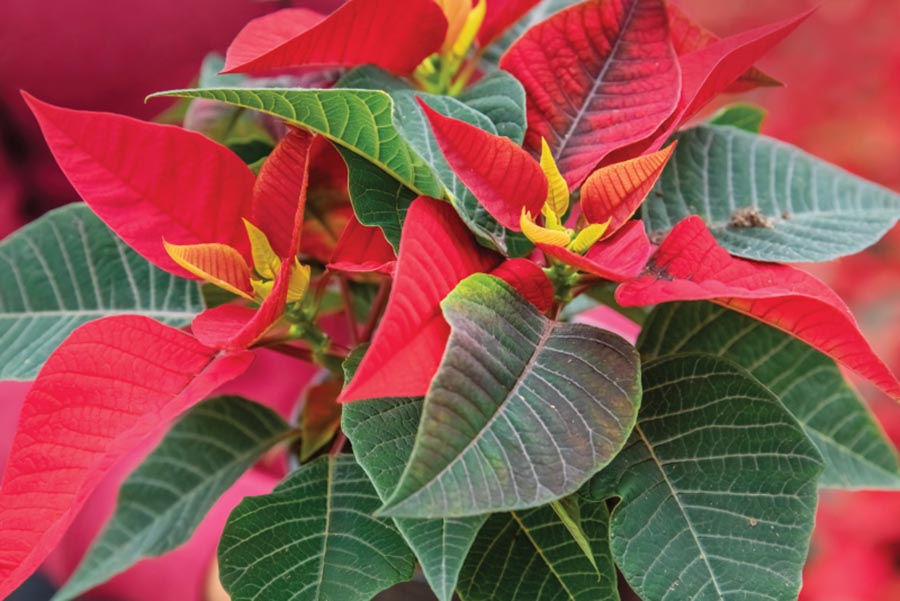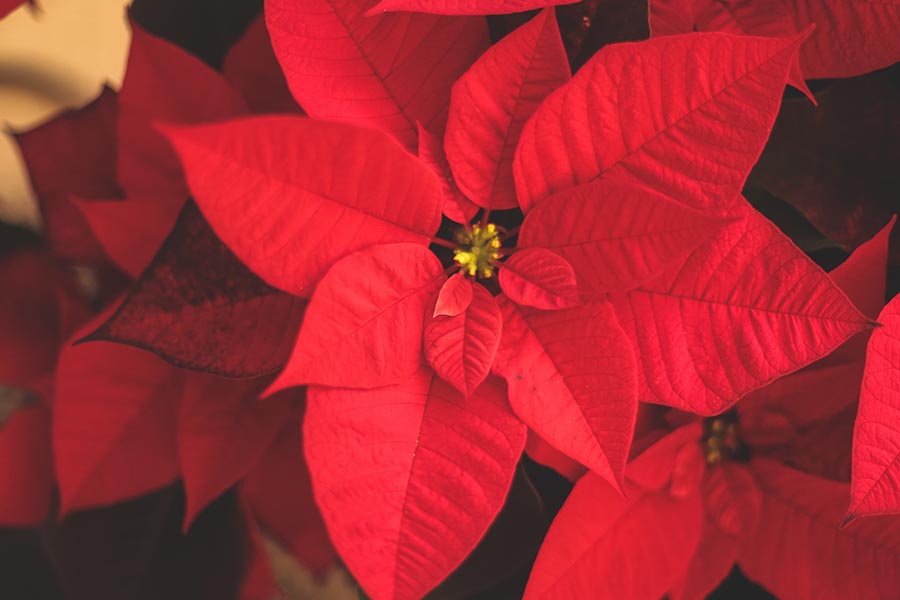
The holiday season is upon us, and many plant and flower enthusiasts agree it wouldn’t feel like the holidays without beautiful, red poinsettias.
“No other plant brings so much color to the winter season. I like to add many poinsettias to my home and outdoors for holiday decorations,” says Tom MacCubbin, University of Florida Institute of Food and Agricultural Sciences Extension Agent Emeritus and host of the Better Lawns & Gardens radio show broadcast. “After the holidays, we add poinsettias to the landscape for winter color. I have been enjoying poinsettias most of my life, first in Maryland and now in Florida for more than 40 years.”
While the traditional poinsettia is bright red, the flower comes in several other colors, too, including white, cream, pink, marble and bicolor.
There are actually hundreds of red poinsettia varieties.
“We grow three different red varieties so we can time them to be available for different parts of the season,” says Craig Roth, president of Sunshine Growers Inc., a 25-acre wholesale plant nursery in Fort Meade. “Some are ready at Thanksgiving, others are ready the first of December and others later in December.”

Growing Poinsettias
Sunshine Growers starts growing poinsettias in July, and the first ones are ready to sell in October.
“We start our poinsettia season with a Love You Pink variety that is the color of breast cancer awareness, and we sell that one in October,” Roth says. “Then for Thanksgiving, we grow two varieties that we paint with copper glitter paint so they have a fall look. Those are more apricot-colored, and they’re called Premium Ice Crystal and Viking Cinnamon. The copper glitter makes them look great for a Thanksgiving table.”
In December, Sunshine Growers sells its novelty collection, including the classic red Winter Rose variety.
“Some have different colors mixed on the same petals, some are shades of pink and some are whites,” Roth says.
In frost-free areas like Florida, poinsettias tend to grow very well – and quicker than in colder climates.
“Poinsettias are our largest single crop; we grow about 200,000 plants of varying sizes each holiday season, from 12 inches tall to 28 inches tall,” Roth says. “Warmer climates allow them to grow a bit faster, and down here in Florida, it can be tricky to keep them the right size, so they don’t get too overgrown with the heat and amount of rain and humidity we get.”
See more: How to Choose and Plant the Best Tree for Your Space

Poinsettia Care and Maintenance
Poinsettias are relatively easy to care for. They need watering every three or four days (or when the soil feels dry to the touch). After the holiday season, poinsettias can be planted outdoors in partial sun. Poinsettias thrive on sunlight, but they also need dark nights in order to bloom.
“If you plant them out front and a streetlight comes on, they won’t bloom in time because the light disrupts their cycle,” Roth explains. “They need dark nights; the day length getting shorter helps them to bloom.”
With proper care, poinsettias can live for years. MacCubbin recommends fertilizing them with a slow-release landscape product and pruning them around March to within 12 to 18 inches of the soil. When they get a foot of new growth, remove 4 to 6 inches from each shoot, and continue doing so through the end of August so they can mature.
“They initiate the flowering process in mid-October,” MacCubbin says. “If they get any nighttime light during October and early November, their flowering will be delayed or prevented.”
At Sunshine Growers, Roth says the poinsettias don’t require any marketing because people are always eager to buy them when the time comes.
“For Christmas, poinsettias are the best-known flower,” he says. “It’s often said the poinsettia crop starts off green, then turns red, but as a grower, you have to turn it back to green to make money.”
After many years, Roth still enjoys watching their progression each season.
“It’s still interesting to see their leaves change from green to full red between October and mid-November,” he says. “The change happens naturally in such a short period of time, from totally green to totally red or pink, just in time for the holidays. As many times as we’ve done it, I still love that.”









I live in Jupiter and want to expand my poinsettia cultivars. What bicolored or variegated varieties can I buy from you?
Smaller the plant the better. Thank you.